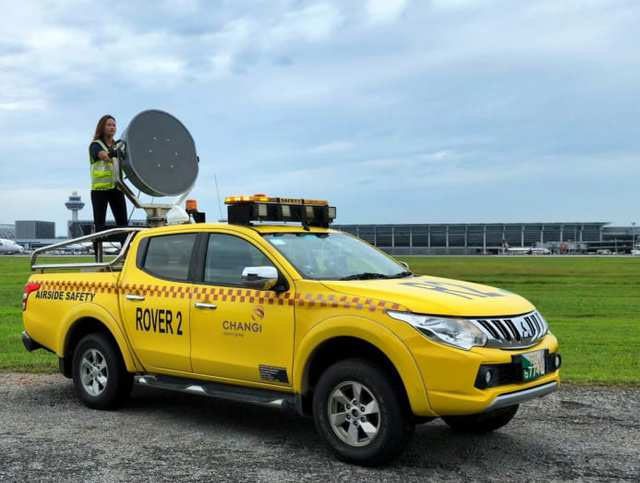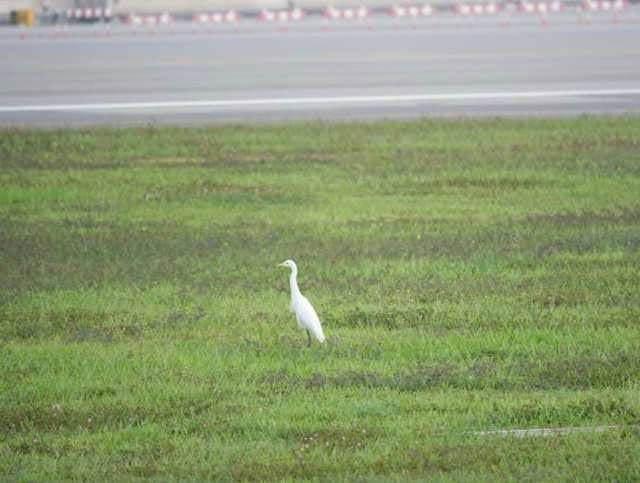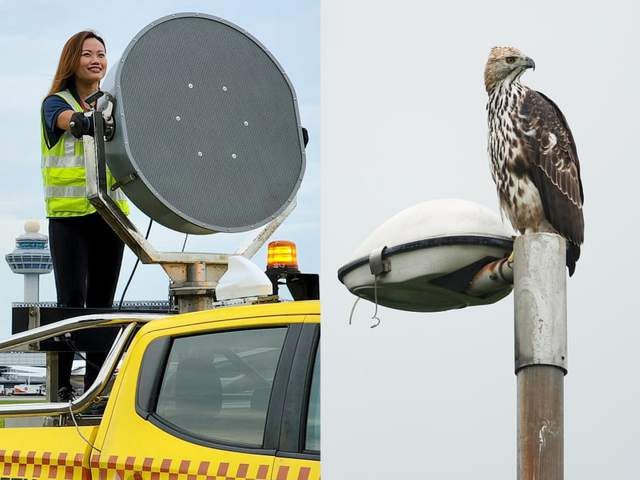Her job may seem simple, but in reality, it demands a lot and carries numerous risks.
Did you know that bird strikes can pose a significant danger to aircraft, especially during takeoff and landing?
Wildlife expert Yap Xinli spoke with CNA Women to share her unique role in keeping the runway safe, ensuring it is “spotless” and free of any animal presence.
A Special Job at the Airport
Yap Xinli, 37, is currently the Operations Planning Manager at Changi Airport Group, where she oversees the management of wildlife that poses a threat to safety at Changi Airport in Singapore.
Her team is responsible for ensuring the airport area, where flight activities take place, is free of any wildlife, which can include birds, dogs, cats, lizards, snakes, and even bats.
Ms. Yap and her colleagues have a deep understanding of the airport layout, including gaps that could allow wildlife to easily enter the area.

Ms. Yap Xinli with her colleagues.
Their work takes place over 12 hours each day, starting promptly at 6:30 AM. They patrol the airport in a specialized vehicle, looking for wildlife such as birds that may appear on the runway. In addition to birds, snakes, stray dogs, cats, and lizards often wander into this area.
Changi Airport has two active runways, so they split into two teams, with each team responsible for one runway, patrolling the 4 km stretch throughout the day.
Ms. Yap holds a degree in biomedical science and a master’s related to wildlife. Previously, she worked as a conservation officer at the Singapore Zoo and later engaged in research on zoonotic diseases.

Yap Xinli in a specialized vehicle.
Ensuring Flight Safety
She joined Changi Airport Group in April 2017. Yap Xinli is the only member of her team with the educational background and experience required to manage wildlife risk at the airport.
Yap has trained her team in methods to identify wildlife that strays into the airport and how to use specialized equipment to drive them away.
“For birds, we can easily let them fly away to another location. However, for other wildlife, we try to guide them out of the airport.
We have double fencing, which is very secure to prevent stray dogs and cats from entering. But occasionally, we still find them climbing over the fence,” Ms. Yap shared about her work.

Birds always pose a high risk.
This job requires seamless coordination among team members. For example, one person needs to open the gate while another directs the animal towards the exit.
“Sometimes we see lizards and snakes moving on the runway. However, they do not pose as much danger to aircraft as birds do,” Ms. Yap noted.
Dangerous Threats to Flight Safety
When a flock of birds collides with an aircraft in flight, it can lead to significant dangers. Ms. Yap Xinli’s team’s mission is to prevent this from happening to ensure the safety of pilots and passengers on board.
“Birds can fly into engines, crack windshields, or impact the radome (the radar cover on the aircraft). Many passengers are unaware that such risks can occur,” Yap Xinli explained about the potential hazards aircraft face when encountering stray flocks of birds.
On January 15, 2009, US Airways Flight 1549, an Airbus A320, experienced a historic incident. Just minutes after takeoff, a flock of birds crossed the aircraft’s flight path.

Historic aviation incident caused by birds.
Several birds struck both engines of the aircraft, causing them to catch fire and fail immediately. At this point, the plane was at an altitude of about 1,000 meters over the Bronx area of New York City.
After failing to restart the engines, Captain Chesley “Sully” Sullenberger, a pilot with over 40 years of experience, decided to glide towards the Hudson River in New York to prepare for an emergency landing. All 155 passengers survived, and Captain Sully’s miraculous landing made him a hero overnight.
Ms. Yap explained that birds typically fly at altitudes where they can easily collide with aircraft. Larger birds, such as white-bellied sea eagles, pose a higher risk as they can cause more damage to aircraft.
Her team is particularly cautious during migratory seasons when large flocks of birds are flying. In Singapore, migratory birds are commonly spotted from September of this year to March of the following year.
Memorable Moments in a Unique Job
During patrols, teams use various tools and equipment to disperse wildlife. One of the most popular tools is the Long-Range Sound Device, which resembles a large speaker and emits sound waves up to 2 km to scare away birds.

Ms. Yap Xinli plays a crucial role in removing animals that threaten airport safety.
“Birds are really intelligent. Therefore, we must continuously look for new tools to maintain the upper hand. We need to be more creative,” Ms. Yap laughed.
The biggest challenge Yap faced when she started was working with stakeholders and the local communities surrounding the airport. Although they are not part of the airport, Ms. Yap’s team needs to help them raise awareness about actions that can attract wildlife to the airport, such as not properly covering trash bins.
“It takes quite a while to explain to the public. We often meet and talk to help them better understand the potential dangers,” Ms. Yap explained.
Despite the pressure, Ms. Yap finds the job quite interesting: “It is never boring. There are always surprises every day. Sometimes you encounter birds you have never seen before appearing on the runway.”
She also expressed her gratitude that wildlife strikes at the airport have decreased over the years. She takes pride in seeing her team, who joined the work without prior knowledge, become experts in managing wildlife risks.
“I started this job with the thought that we would chase all these animals away, and as a typical Singaporean, we must reduce (wildlife strikes) to zero.
Our job is to prevent wildlife from affecting flights. We do our best to manage risks. Nowadays, you see wildlife coming into urban areas more. People need to learn how to manage themselves and animals so that we can coexist harmoniously,” Ms. Yap noted.


















































